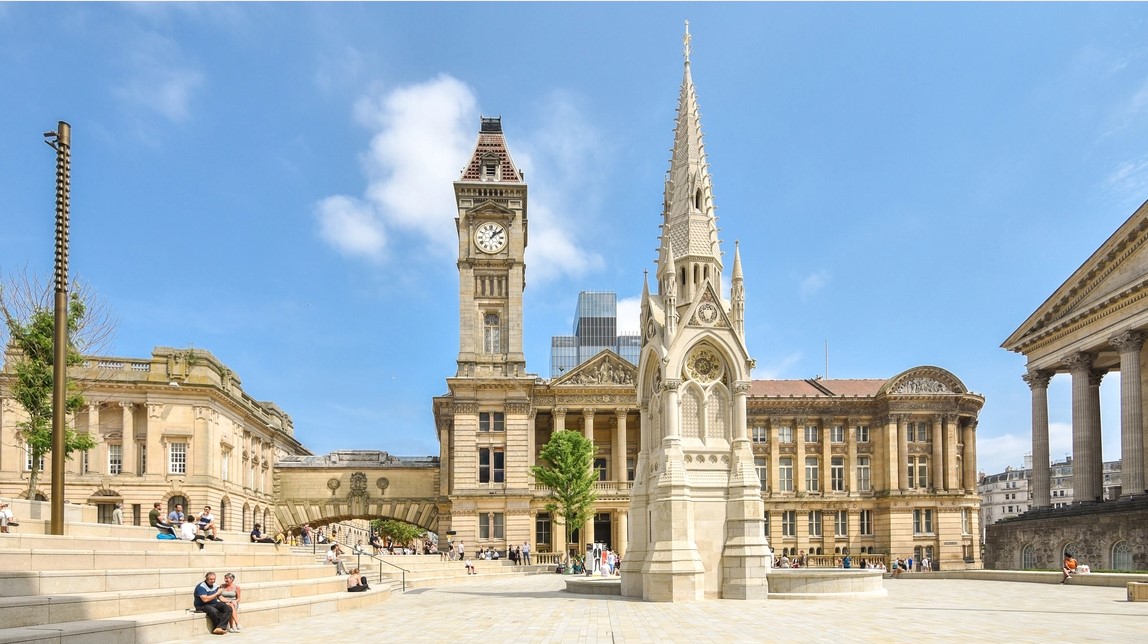The best free self-guided walking tours
Birmingham 1
Birmingham Museum and Art Gallery – Where Industry Meets Art
- Open Wednesday – Sunday, 10am – 5pm
- General admission is FREE
- Some events and exhibitions may charge, this information is included in the museum’s What’s On page
Ascending the grand marble staircase into Birmingham Museum and Art Gallery, you’re literally climbing the steps paid for by industrial wealth. This magnificent building, opened in 1885, was designed to show that Birmingham wasn’t just about manufacturing – it was a city that could rival any European cultural capital.
The Industrial Gallery, though no longer in its original Victorian layout, remains the heart of the museum’s connection to Birmingham’s manufacturing heritage. Here you’ll find an outstanding collection of metalwork that showcases why Birmingham was known as the “Toy Shop of the World” – not for children’s playthings, but for the small, precision-made metal items (like buckles, pins, and boxes) that made the city famous. The Pinto Collection of wooden objects and the Aston Manor metalwork collection reveal the extraordinary skill of Birmingham’s craftspeople.
Look up at the elaborate gas chandeliers, now converted to electricity. These were manufactured locally and deliberately oversized to demonstrate Birmingham’s mastery of metalworking. The ornate ceiling decorations include industrial motifs – look for the intertwined patterns that subtly incorporate tools and industrial symbols.
The Pre-Raphaelite collection, one of the world’s largest, might seem removed from industry, but its presence here is directly linked to Birmingham’s manufacturing wealth. Local industrial magnates like Richard Tangye were among the first to collect these works, seeing them as the perfect combination of art and craftsmanship. The paintings’ emphasis on medieval craft skills resonated with Birmingham’s own tradition of skilled metalworking.
In the Round Room, the original centre of the museum, the dome’s acoustics were carefully designed to carry the voices of industrial leaders making speeches at civic ceremonies. The room’s elaborate decorative scheme includes representations of industrial trades alongside classical figures – look for Vulcan, the god of metalworking, given prominence among the Greek deities.
The Edwardian Tea Room, while famous for refreshments today, was originally conceived as a meeting place where industrialists could network while surrounded by cultural refinement. Its high ceilings and ornate plasterwork were designed to impress visitors with the sophistication that manufacturing wealth could buy.
Don’t miss the Industrial Gallery’s display of locally-made glass and ceramics. These showcase how Birmingham’s industrial expertise extended beyond metalworking to other materials. The Staffordshire enamels demonstrate how industrial processes were adapted to create objects of remarkable delicacy and beauty.
Even the building’s stone exterior tells an industrial story – the blackened sections are remnants of the city’s industrial pollution, deliberately preserved in places to record this aspect of Birmingham’s history. The museum’s Victorian gas lighting system, though no longer in use, was one of the most advanced of its time, demonstrating how industrial innovation was incorporated into cultural buildings.
As you explore, remember that this museum wasn’t just about displaying art – it was about showing how industrial Birmingham could transform raw materials and manufacturing expertise into objects of beauty and cultural significance.
Next, we’ll move to Chamberlain Square, named after the family that helped transform Birmingham from an industrial powerhouse into a modern city…

